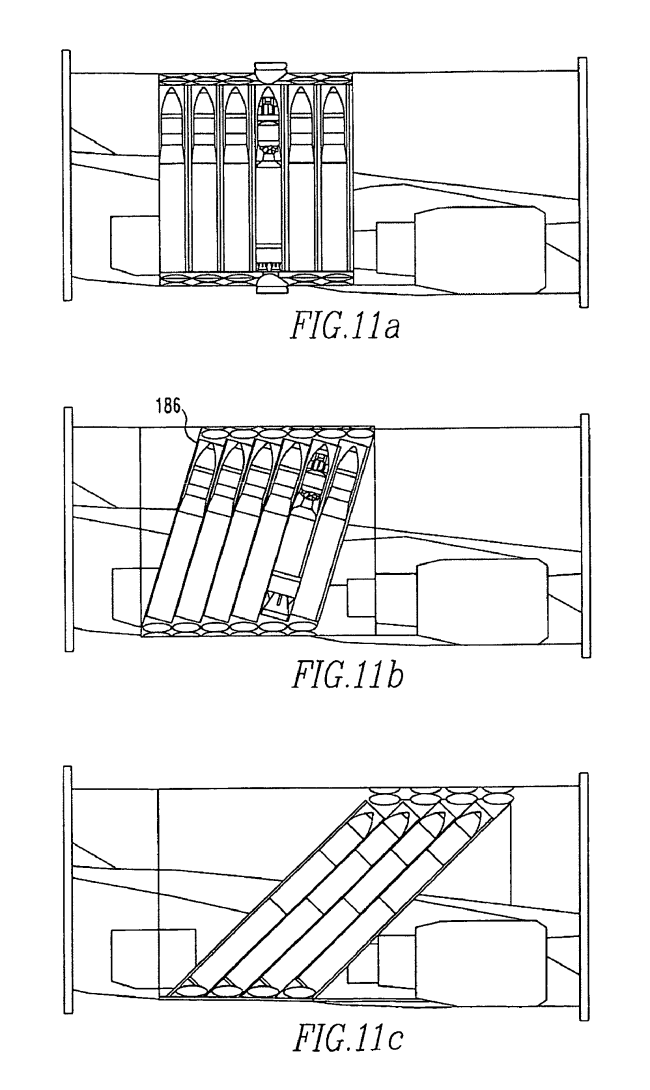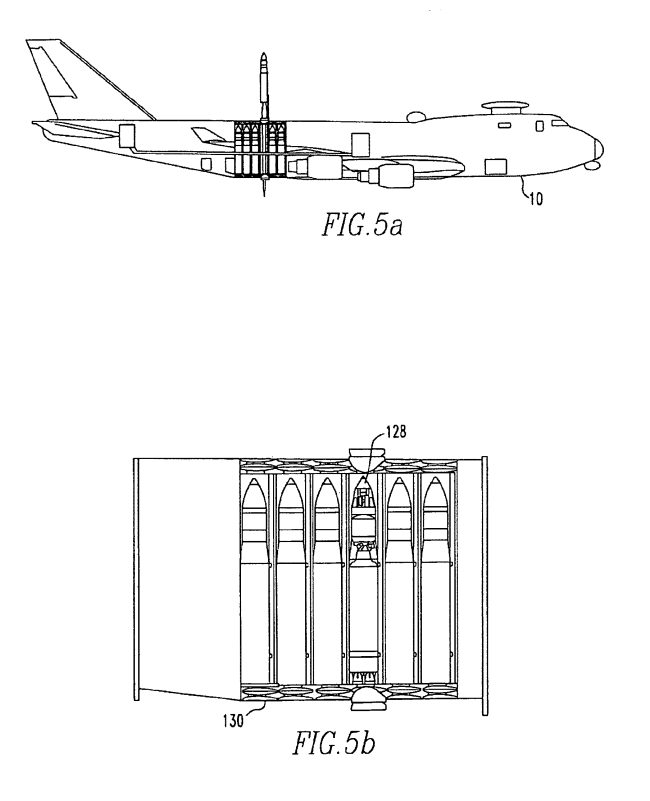Sometimes you see stuff that makes you sad… not because the thing itself is sad, but because you can’t legally say jack about it. Well, back when I worked at ATK I stumbled across some Powerpoint presentations on a joint ATK/BAE concept, and due to the interesting notations on the pages I felt it safest to not say a thing. BAE patented the concept a few years ago with all manner of nifty diagrams, so.. restriction lifted, I guess.
The concept? Flying ICBM launcher. This is not a new idea… the Skybolt ICBM was flying around under the wings of several bombers back in the 1960’s, and both the Minuteman and Peacekeeper ICBMs were proposed to be made air mobile at various times… typically by the relatively simple expedient of carrying them in cargo planes and shoving them out the back door. But what sets this concept apart is that the ICBMs are carried *vertically* in silos, just like on ballistic missile submarines. But here there is no compressed gas charge to blow them out; they come out hot.
The first obvious problem with the concept is that, unlike a submarine, a jet aircraft at 40,000 feet is hardly likely to just stop… thus the missile will have some pretty substantial side forces on it as it comes out, to the tune of a 500+ mile per hour air blast. Anyone who has ever tried to launch a model rocket in a stiff breeze has probably noticed the concept of “tipping force:” when the rocket is only partly exposed, the wind blowing on the front of it tries to blow it over sideways. But BAE seems to think they’ve got the problem licked: by redirecting some of the exhaust gasses into a plume firing out the top of the aircraft and just ahead of the rocket, the air flow should be diverted around the missile long enough for it to clear the silo. A neat idea… I’d love to see some full scale testing!
The second obvious concern is that aircraft skins and structures *really* don’t like having big rocket motors blasting away at them from ranges of a few feet. BAE has a solution to that, too: a short-burn, high-thrust rocket motor capable of chucking the missile into the air, but fast-burning enough so that it burns out before it actually clears the tube. The missile would then coast upwards until it was clear of the aircraft, stage off the booster, then fire up its first *real* stage and continue on its merry way.
BAE suggests that the missiles can be used for a number of roles:
1: micro-satellite launching (but who’d need to ripple-fire dozens of small satellites?)
2: Missile defense
3: Prompt strike.
In the last role, one concept described is a 747 carrying 32 or more missiles, each missile capable of launching a 2000-pound JDAM weapon a range of 500 or more miles.
The patents:
Air based vertical launch ballistic missile defense 7540227
Air-based vertical launch ballistic missile defense 7849778
 Thought is given in the patent to angling the tubes forward.
Thought is given in the patent to angling the tubes forward.
When I saw the presentations at ATK, I was uncertain as to the breakdown of who was to do what. But it now seems pretty clear to me that the idea as a whole was BAE’s, and ATK was pitching rocket concepts to BAE to fit their aircraft boomer. Whether ATK got the job or if it went to someone else, or if the whole idea just dried up and blew away, I have no data. The concept dates back at least 6 years, to 2005 or earlier. It got a smidgeon of press, then pretty much vanished. In all probability it really did vanish. But who knows…
NOTE: If you like aerospace history posts like this, then you’ll go out of your mind when you read Aerospace Projects Review. Go take a look.
17 Responses to “Flying Boomers”
Sorry, the comment form is closed at this time.

Why not drop the missiles down, keep them stabilized by some means, and ignite once the aircraft is clear?
Just a guess mind you but if its a just a gravity release the wind blast might cause some bending and twisting before its fully clear of the tube. If you’re going to use force to make it go down then why not go up instead? That way you don’t have to worry about the stabilization, etc.
Yeah, if the idea is crazy from the word go, then the British are involved somehow, trying to get some investment in it from us.
You had better hope that missile can really gimbal its exhaust nozzle on leaving the aircraft vertically at 500+ mph, or it’s going to end up going sideways right after launch, like a Estes rocket launched on a windy day. Also, how do they avoid going right back into the vertical fin once the wind hits them?
Finally found a illustration of the He-177 version that was supposed to fire up 210 mm rockets vertically from below bomber formations todestroy them, which looked a lot like this concept:
http://i37.photobucket.com/albums/e68/GTwiner/he-162/177Roc.jpg
I have a dim memory of a 747 proposed as a launcher for cruise missiles. Boeing talked about 132 missiles fired horizontally out the sides.
Solution: missile pods. Pack the missiles into disposable launchers built to fit in the cargo bay. When desire launch point is reached, open belly doors and drop entire launcher like a bomb. Once safely away from the carrier, the launcher declerates and self-stabilizes using a drogue ‘chute and assumes a vertical position. A parawing is deployed. The missiles are then ripple-fired through the parawing.
This would work even better with a military cargo plane. No need to modify a 747; just roll the missile pods out the back door.
In the words of Cartman, “sweeeeet”.
Didn’t the Vigilante drop it’s bombs out of it’s tail.
They made a model of the cruise missile carrying 747, it was awe-inspiring and looked pretty easy to do: http://www.g2mil.com/bm747.htm
That’s weird, that was supposed to reply to another posting in this thread.
The Vigilante did have a tubular bomb bay that went between the twin engines and was supposed to eject a nuclear weapon backwards with one or two auxiliary fuel tanks attached to its tail.
It didn’t work well during tests, with the bomb/tank combo sometimes not fully leaving the aircraft, and at other times starting to follow the aircraft around as it was caught in its shockwave at supersonic speeds. It also had a unfortunate tendency to break free under the stress of a catapult launch and slide out onto the carrier deck on launch like a egg from Hell, which made the deck launch crew uneasy. 😀
The RA-5C recon version kept the launch tube capability, but only operationally used it for storage of extra fuel.
One cool idea North American had was to stick a third jet engine or rocket engine into the tube bomb bay, and turn the Vigilante into a high performance Air Force interceptor, sort of a poor man’s version of the F-108 Rapier:
http://www.murdoconline.net/archives/5591.html
http://prototypes.free.fr/a5/images/a5_21.jpg
I don’t know what flight endurance would have been like, but it would’ve really moved, and had a climb rate that would have been something to see.
I think that if you angle the missiles backward it would probably work best if you really think about it in my opinion.
I’m puzzled by their fore-aft location. Given their weight density I’m suprised they’re that far aft.
Extra fuel in the forward part of the passenger area?
[…] was browsing the web and came across this post about Air-Launched ICBMs. I remember a video showing a Minuteman I being Air-Launched out the back of a C-17, so […]
I love the concept of Air Launched ICBMs, but they don’t have a place in today’s military. Perhaps at the hieght of Lemay’s alert force we could have found a use for them. Would they have counted as ICBMs, Bomber weapons, or would they be their own seperate leg to the triad?
> they don’t have a place in today’s military
Not so much anymore. The point of air mobile ICBMs was generally to keep them from getting blasted by a massive Soviet first strike; this is, at least for the moment, a lesser concern.
However, the primary described role of anti-missile system does make a good deal of sense… You could have half a dozen ABM 747’s available, and have one always orbiting near some likely launch country like North Korea or Iran.
[…] long time that the 'Air Launch' concept had been developed in the past. However I just came across a blog that detailed BAE's fairly recent patent for an aircraft that vertically stores and launches […]
[…] substantially less crazy-sounding idea than jetliners launching large missiles vertically, in the late 1970′s Boeing (and others) studied the use of cargo jets to carry and launch […]